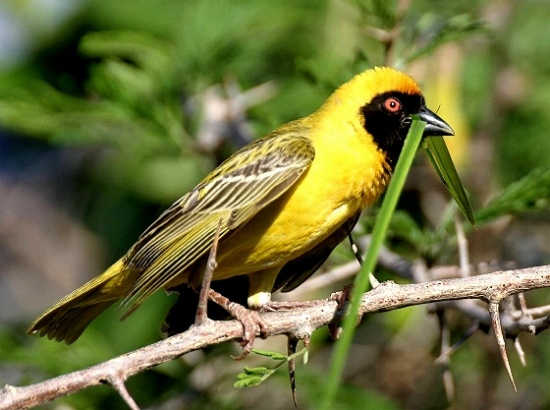Alternative name: African Masked Weaver
Includes Vetelline Weaver
- Ploceus velatus
Identification
Length: 13 cm (5 in), mass 29-45 g. Males larger than females
Breeding male:
- face, throat and beak black. Black extends above beak base in a band
- eye red
- head and underparts bright yellow
- back plain yellowish-green
- bill short, strong, conical
- legs pink-brown
Adult female and non-breeding male:
- bill pink-brown (not grey contra one field guide)
- throat yellow or orangey fading to off-white on the belly
- brown or red-brown eye
- upper parts yellow-olive, streaked darker on the upper back
- rump diffuse yellowish (not extensive or marked)
The non-breeding male resembles the female but retains the red eye.
Juvenile: Similar to the female.
Similar species
Some Village Weavers have a black mask similar to the mask of this species, but they do not have black above the bill.
Distribution
Africa:
Western Africa: Democratic Republic of Congo and Angola
Eastern Africa: Zambia, Mozambique, Malawi
Southern Africa: Namibia, Botswana, Zimbabwe, South Africa, KwaZulu-Natal, Lesotho and eSwatini.
Taxonomy
Subspecies
Clements recognises the following subspecies [1]:
- P. v. velatus: Western Cape, Northern Cape and Free State
- P. v. nigrifrons: Eastern Cape, northern and western Natal and western eSwatini
- P. v. tahatali: Zimbabwe, south-eastern Botswana, south-western Mozambique, eastern eSwatini, north-eastern Natal
- P. v. shelleyi: Zambia, Malawi and Mozambique
- P. v. caurinus: Southern Angola, Namibia, Botswana and northern Cape Province
- P. v. finschi: Coastal Angola
Subspecies tahatali, shelleyi, caurinus and finschi are not recognised by all authorities [2].
Habitat
Shrubland, savanna, grassland, coastal fynbos, open woodland, inland wetlands, semi-desert areas, suburban gardens, and parks.
Behaviour
Diet
The diet includes insects, seeds and nectar, and it will come to feeding tables.
Breeding
They nest singly or in small colonies, mainly from September to January. The males build up to 15 nests in a season and have several female partners. The nests are woven from reed, palm or grass and built in a tree or in reeds. A female selects a nest and lines it with soft grass and feathers. One to six eggs are incubated for 12-14 days by the female.
Parasitised by Dideric Cuckoo.
References
- Clements, J. F., T. S. Schulenberg, M. J. Iliff, D. Roberson, T. A. Fredericks, B. L. Sullivan, and C. L. Wood. 2017. The eBird/Clements checklist of birds of the world: v2017, with updates to August 2017. Downloaded from http://www.birds.cornell.edu/clementschecklist/download/
- Avibase
- Wikipedia
Recommended Citation
- BirdForum Opus contributors. (2025) Southern Masked Weaver. In: BirdForum, the forum for wild birds and birding. Retrieved 25 April 2025 from https://www.birdforum.net/opus/Southern_Masked_Weaver
External Links
GSearch checked for 2020 platform.1







